|
|
Review GSM phone Nokia 6111
Standard kit:
- Nokia 6111 Phone
- Nokia Battery BL-4B
- Nokia Travel Charger AC-4
- Nokia Classic Stereo Headset HS-23
- Nokia Charger Adapter CA-44
- Nokia Connectivity Cable CA-53
- CD-ROM c PC suite
- Manual
It's typical for Nokia to wait for other companies' all-new devices success and then release its own solutions, judging the outcome of these undertakings. This approach is justified, taking into account that Nokia is the leading company on the market and loyalty of consumers to its products is very high. This destiny followed clamshells - remember Nokia 7200 at least, which was frankly a weak product, but had fairly good sales and as a consequence wide dynamics of price shift. The following clamshells became more popular and their numbers have considerably risen since then. Almost the same thing is happening to sliders .

Nokia 6111 is positioned as a middle-end solution, and targeted both at men and women. Distribution of the audience may vary from 50 to 60 per cent in favour of women, depending on the country. Though this solution is universal.

The model has a distinct design compared to all the existing sliders – the device has its unique look. Measuring 84 õ 47 õ 23 mm, and weighting 92 grammes, the handset is easy to carry in any desired manner. You can choose from two colors of the shell: back and white. The latter variant is obviously focused on women audience, since it is unlikely to fit men. In both cases plastic of the front panel is glossy, so is the back panel. The side panels are made of dull plastic, which makes appearance of the device rather expensive. The glossy surfaces are easy soiled, but the handset doesn't look muddy in practice owing to contrast of the sides and the main part. On the whole it's a rare case when a device combines both of these components.

When closed the device has a small backlash in the bottom part, however it's a prudent move rather than a miscalculation of the manufacturer. Taking into consideration small height of the body, it would have required your hand to be well-positioned in order to flip the device open at some angles, if the handset had had firmly fixed halves. Though here it's easy to open the phone with a help of well functioning automatic finishing mechanism (this is also emphasized in the advertising slogan of the model). Being flipped open, the halves of the device don't have any gap at all. At the same time it's possible to use the handset even in closed condition: you still can read messages, answer the calls and so on. The microphone is located in the upper half, practically in the middle of the bottom side in closed mode. This position of the microphone is also quite justified when the handset is opened .

The functional keys are medium-sized and easy to use, though the navigating key is smaller than it could be. Due to this, integrated into it “OK” key will not suit people with big fingers. Alphanumerical keyboard is made of the same type of plastic and is very comfortable, as you won't experience any difficulties even with the keys bordering on the upper flip.

When pressing a key you can feel its stroke and this adds even more comfort. Unfortunately, functional keys utter slight creaks while being pressed - this spoils a bit the overall impression. On the other hand alphanumerical keys don't have this defect. White backlighting of the keys is visible in any conditions. And the last but not least – on keys of localized devices you will find two rows of symbols.



The display of this model features 128 õ 160 pixels resolution (TFT), which is very little for a product of this level nowadays. At the same time, Siemens SL75, for example, has the similar resolution of the screen. The 262000 color display provides bright and vivid picture, though it's inferior in this characteristic to the Korean manufacturers. However it's worth a note that the display itself is well-made with no issues discovered. The screen can show up to 6 lines of text lines and 3 service ones, font size is rather large and easily read. The screen fades in the sun, but font size makes all the difference here and you can still comfortably use the device.

The power key, which is used to switch profiles in stand-by mode as well, is positioned on the upper side of the handset. Interface connector and charger can be found behind a small plastic stub, attached to the phone. Interface connector, in particular, is used to connect the standard stereo headset, and of course this increases the overall size of the device. The headset, distributed with the phone has earphones made of plastic, however covers of foam-rubber are also included.





Back panel holder, marked with red color, can be removed by pressing on it, so you will see the battery.

Don't waste your time on looking for SIM-holder beneath the accumulator – it isn't there anyway. The cutoff point is placed on the interior part of the upper flip, so you can open it when the handset is on as well (the device will automatically turn off). The cell-phone is fully operational even without SIM-card being plugged in, however you will be cut off from your phonebook.

Two volume keys and a camera key are located on the right side of the body. Transfer of all managing elements to the left side is caused by the specific camera mode: the device provides you with ability to shoot even in the closed condition, pretending to be a digital camera. The camera module is placed on the back panel as well as a small mirror and the flash. The camera itself has the resolution of one megapixel – this differs the device from many other modern models. A fully operational IrDA port is situated on the left side of the handset

There are only a few more words to say about the battery. The handset is armed with a 700 mAh lithium-ion battery. According to the manufacturer's statement, it can provide a maximum of 250 hours of life time in stand-by mode and up to 3,5 hours of talk time. In conditions of the Moscow networks, charge of the battery lasted for about 2 days with 45 minutes of talk time, Bluetooth being constantly turned on, and about 2 hours of listening to the radio. Full recharge time of the device is around 1 hour 20 minutes.


Menu
The model is based on platform 40 of the third edition – applying it to the middle-end models is becoming a usual practice for the company. The main difference between Nokia 6111 and the senior models is a low screen resolution which isn't typical, when using the third edition. In practice this ends up in a certain discrepancy in font sizes and skip of some options on the display. On the whole the interface looks quite untimely in some cases, where you have to deal with text - the design looks gigantic and is definitely intended for higher resolutions. It seems, when the company faced with the dilemma, the scale turned to better functionality rather than ethical consistency.
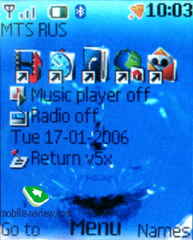
The memory pool of the device is 23.5 Mb, which doesn't look quite enough in light of the fact it has a built in megapixel camera. The handset can't be used as a media player either due to the same lack of storage. Common users are more likely to spend bulk of the memory to store ring tones and photos.

On the phone startup a small clip telling about primary managing elements and device's features is played back, though it's located in the main memory and can be turned off or even deleted (applications directory). When you switch on the phone you can see a standard menu, only the battery charging and signal level icons are different. Similar to the smartphones using Symbian, there is an option of turning on Active Standby. It is a copy to Today screen on smartphones powered by Windows Mobile. When in stand-by mode, the phone will display a line with icons of applications and functions; these shortcuts can be managed by you in any manner. The next thing being displayed is radio status (number of the current preset, name of the station and status). Under this you can find all the information for the current day taken from the organizer (tasks, events), even lower – text banner or a note. User can move to any section and quickly choose it, browse any note in full size, executing a proper application. If the media player is on while in sleep mode, the screen will display the title of the current track.
 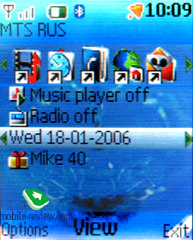
You can pick a special wallpaper and font color for the stand-by mode. For some photos changing the color of the font is an optimal way to shade text on the background of a vivid picture. Functions for the navigation key deviations are determined in a standard way. Icons can be made either visible on the display or hidden (when Active Standby is on they are not displayed and a consequence, don't work).
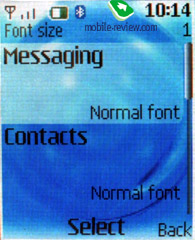 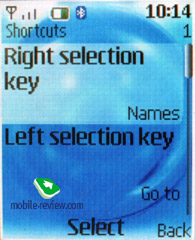
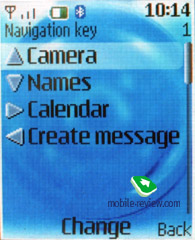 
The flexibility of the device's options deserves a special warm note, since it's one of the best realizations of the interface so far. In particular you can choose an Active Standby or a standard mode with fast access, assigned to the navigation key, and GoTo feature (left soft-key).
The main menu has two different appearances: list (4 items of the main menu displayed) and matrix (9 icons on the screen). In the senior models one can find two more varieties – matrix with captions of the items (9 icons on the screen) and bookmarks (list, grid, grid with labels, tab). Though these two are not featured here since the screen resolution won't let this solution be realized.
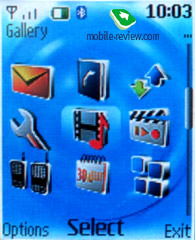 
In all sub-menus lists of items have vertical direction. The design looks extremely attractive owing to the icons; the menu isn't too variegated and instinctively understandable.
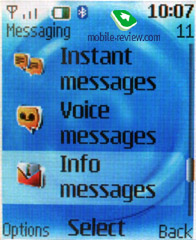 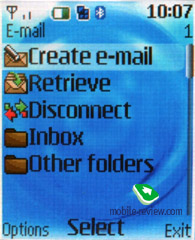
You can choose particular font size (small, medium, large) for three applications – Messages, Contacts and WEB. At first glance there is no big difference between these options, though depending on the chosen type you will have various numbers of text lines displayed on the screen. Maximal font size doesn't make it too bold.
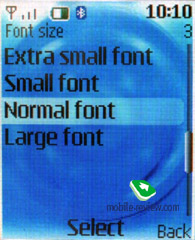 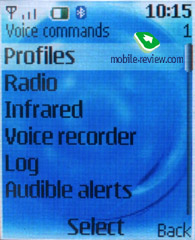
There is also the function which provides fast navigation, using shortcut numbers, moreover, as an addition you are also able to use voice commands. Recognition is available only for preset functions – you will require prior practice and label recording.
Phonebook. You can store up to 1000 entries in the handset's phonebook. Though it can only be achieved if you attach not too much of data to each entry - only one or two fields. In case of average fields filling in, in other words 6-7 lines per name, you will face the maximum of 500 entries. As you might have already guessed, for each name you can enter up to 5 phone numbers and choose the type (main, mobile, home, office, fax). The first submitted number will be automatically set as the number on default; later on you will be able to change it.
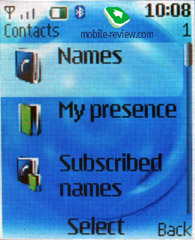 
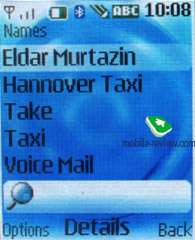 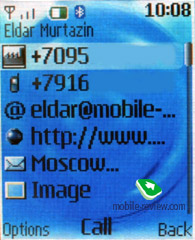
 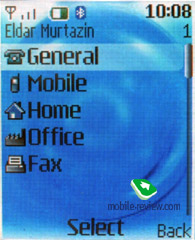
 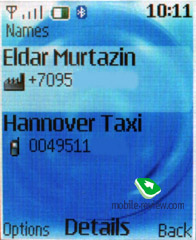
As additional information to each number, you can enter e-mail, homepage, mail addresses, and a text note. Among all other fields free to fill in, the option of USER ID deserves a few words – it is the identifier for the presence service. On the whole it's some kind of ICQ analog, which gives you warning of this user being available at this given moment.
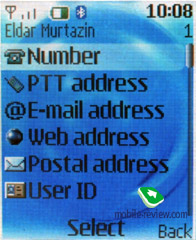 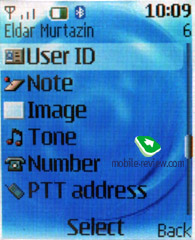
You are also able to add a photo to each number, though when browsing an entry, this picture is not displayed, so you'll have to choose a special option to see it. However you can change settings and have both number and photo being displayed while browsing the phonebook. In this mode the icons will be pretty small and won't give a useful hint about the picture. The other modes of browsing this list are standard – names only, names with default numbers. In the general list both entries from SIM-card and main memory bank of the device can be displayed. One can also set a special ring tone for a certain name in the phonebook.
Following the tradition, keys 2-9 are free to set numbers for quick dial.
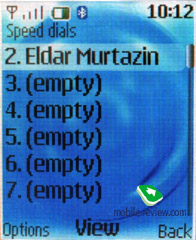
In all up to 100 photos can be correlated with the entries. When receiving a call, you will have the number and the respective photo displayed on the screen. The name and type of the number are shown above the picture since it occupies only a small area of the display.
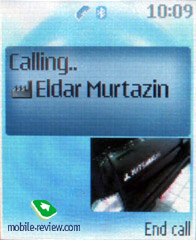
There are no preset groups of subscribers in this phone, thus you'll have to create them yourself. The great advantage of this model is that you can create a maximum of 25 groups of users. For each of them you can set an unique ring tone and image. The photo, set for a certain entry that is a member of a group, has the highest priority and will be displayed instead of the picture applied to the group. One entry can be a member of various groups.
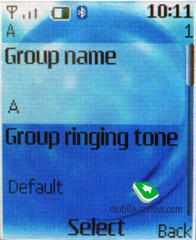 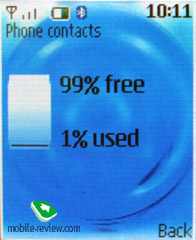
One more surprise awaits you in the general list of entries: groups are displayed in one raw with individual names, but marked with their own icons. Search is executed in both group names and single entries at the same time. This arrangement can be confusing for the first time, but later on you realize all the advantages, as you don't have to look for a specialized item on the menu to access the groups lists (besides, it's accessible only from the main menu, using the soft-key or shortcut numbers, you'll get to the list itself without any options).
Search in the general list can be executed by entering several letters – it doesn't cause any nuisances and works in its usual way. Synchronization with MS Outlook is still not worked out well, in light of the fact some fields are not displayed in a proper way, “First Name” and “Last Name” fields often switch places.
Messages . Similar to Nokia 6230i, the updated version of predicative T9 text input system is used in this model. However here the function of words guess is fully realized, similar as it's done in the handsets by Motorola (iTAP input). When typing letters, you will be offered some variants of words, all new words, in their turn, will be memorized. You can always change input language while typing in any menu, this solution is identical to the one applied to Nokia smartphones.
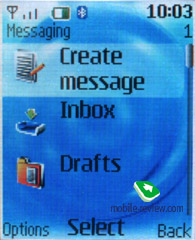 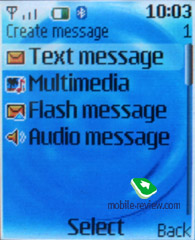
 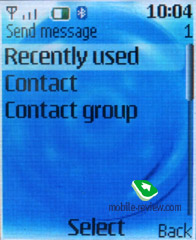
 
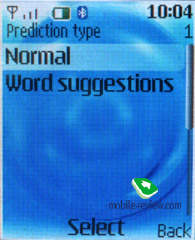 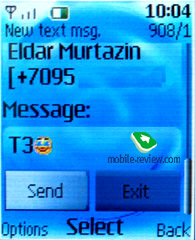
 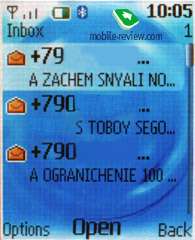
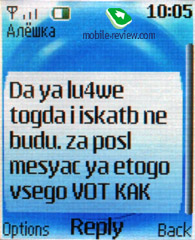
The device supports Nokia Smart Messaging standard, that allows the user to send and receive from other compatible devices ring tones and simple black-and-white pictures. Besides Nokia mobile phones, this messaging type is supported by the handsets of Samsung, LG, Motorola. The rest of the characteristics set is quite common – up to 150 messages in sum, support of emotion icons (converted from text in the received messages) and concatenated messages. There is also a function for automatic replacement of messages in Outbox folder in case of memory overflow (messages will be deleted one after another beginning with the oldest one).
Flash-message is a variety of SMS that is displayed on addressee's screen and is not saved in the memory of his device.
The company considers MMS as a full replacement for EMS. In fact, this solution is becoming more common and using it one can make up even more interesting messages, which include photos, colored pictures, ring tones etc. Each message can be up to 300 Kb in size. That's why the MMS service is well-materialized in this handset – photos, made by the built in camera are automatically scaled in order to be attached to a message. If size of the shot doesn't exceed these 300 Kb or a bit less than that, it can be sent without any further changes in the body of the message.
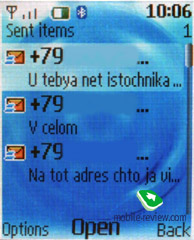
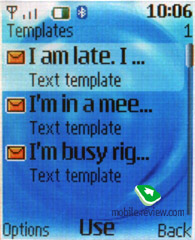 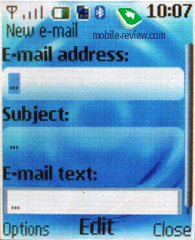
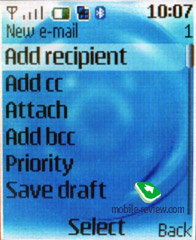 
Voice Message – a variation of MMS, when you record a voice message, lasting up to 3 minutes 6 seconds (maximal duration), and then send at the same moment. This is a simplified kind of MMS made for the masses.
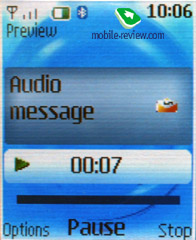
The device has an integrated mail client, which can deal with APOP/POP3/SMTP/IMAP4-protocols. Number of functions here has been significantly widened – added support for all attachments that can be recognized by the device, e.g. 3gp, MP3. However support of .ppt, .doc, .xls and .pdf isn't featured here. The phone can work only with one Russian coding - Ñ 1251, which means that any letter written in KOI8 won't be read, as well as any other letter that underwent forced conversion. In fact there are some improvements concerning the mail client, as compared to 6230i, but it still has many issues to be solved.
Call lists . There are three call lists in the device – received calls, dialed numbers and missed calls. Each of them can hold the maximum of 20 entries. When browsing any of these lists, you can already see the time and date of the call, and it's fairly convenient. Having pushed the call button while the device is in sleep mode, you will be sent to list of the most recent dialed numbers. It's not very comfortable, since in the majority or the competing devices there is either merged list of calls or fast switching from one to the other. Here you're forced to remember where is the number that your require to dial, in which list and so on – it's not always easy to do so.
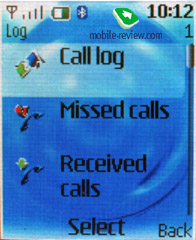 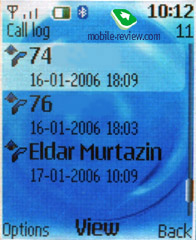
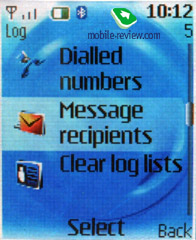 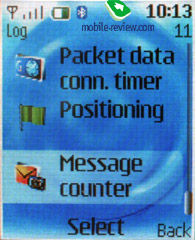
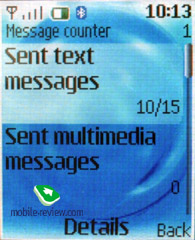
Settings. Profiles can be activated either from the given menu or by pushing the power button. Each profile can be set to be active for a certain time span, and afterwards it will switch to the default one. Sound notifications can now be customized for all events, ring tone – for all types of calls, or for certain groups and people. The way Nokia incarnated the profile system is one of the best on the market.
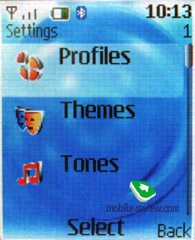 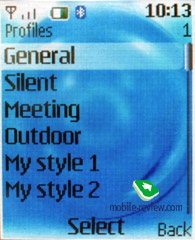
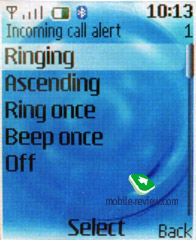 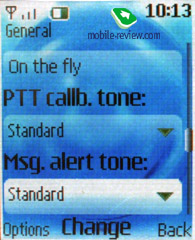
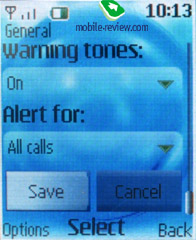
The device features automatic keyboard lock, besides this you can set a special security code that will prevent everyone but yourself from using the handset. You can set behavior of the device for all accessories, e.g. the phone will automatically activate a profile when headset or charger is plugged in. An attractive ability that allows to precisely adjust your device according to your own likes.
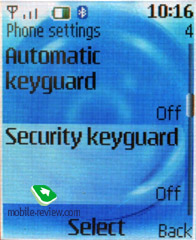 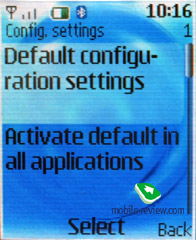
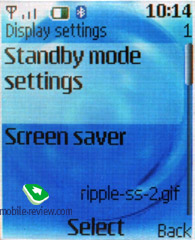 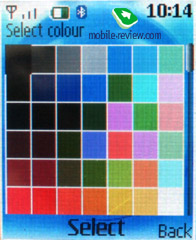
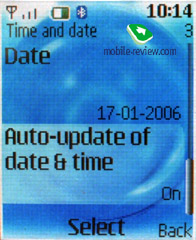
Gallery . All appropriately named folders that contain various files are gathered here. You can browse the folders in pattern of a list, list with names or icons. For any graphical files, including video, full screen mode is supported (horizontal view for video).
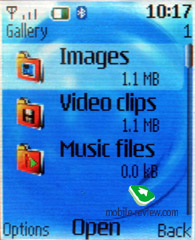 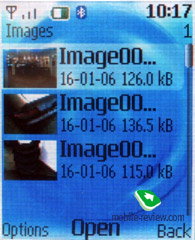
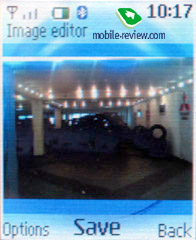 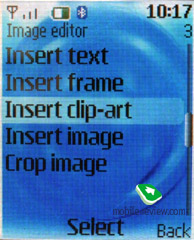
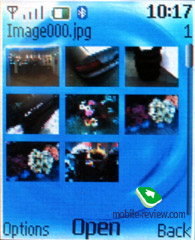 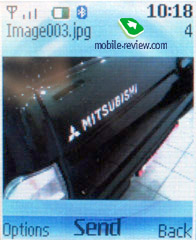
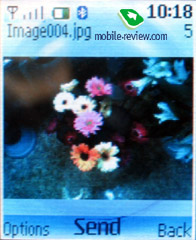 
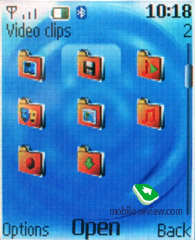 
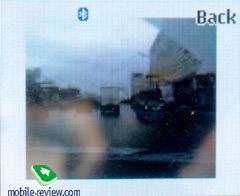
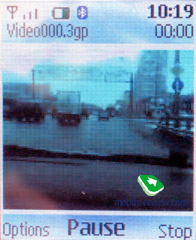 
Media . In this section one can find all the settings connected with the multimedia functions of the device. Let's start looking through them with Camera.
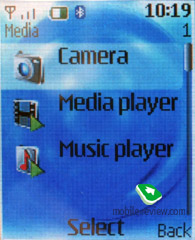
Built in camera allow to make photos with the resolution of one megapixel - 1152 õ 864, also 640 õ 480, 320 õ 240, 160 õ 120 pixels. The quality of the shots is quite fair – they look pretty good on the screen (owing to the display itself). When it comes to viewing the pictures on PC, these photos appear to be on one level with the others, made by the devices of the same category (actually, they are better than Nokia 6230i, as to me). Camera has ascetic settings, there are three types of quality, shots compression and a mode for night shooting. Extension of all saved pictures is JPEG
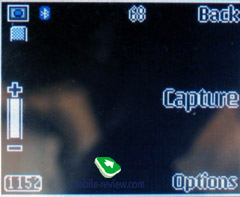
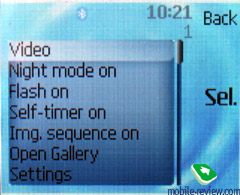 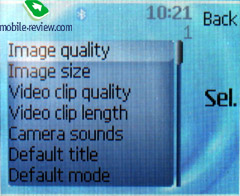
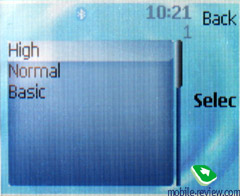 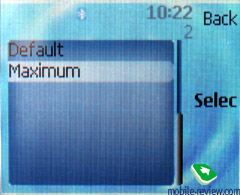
To mention additional settings, that can be find in the camera's menu, night mode, flash activation (works only when the shutter is clicked) and non-adjustable timer, set for 10 seconds, are noteworthy. There is shots consecution feature that works in any resolution.
Shots comparison: Nokia 6111 on the left, Siemens SL75 on the right: :
|
|
 |
 |
(+) increase, 1152x864, JPEG |
(+) increase, 1280x1024, JPEG |
 |
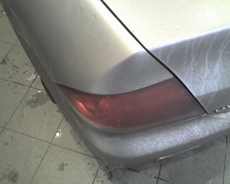 |
(+) increase, 1152x864, JPEG |
(+) increase, 1280x1024, JPEG |
|
|
 |
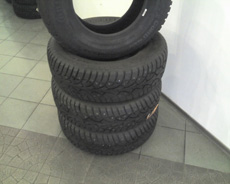 |
(+) increase, 1152x864, JPEG |
(+) increase, 1280x1024, JPEG |
|
|
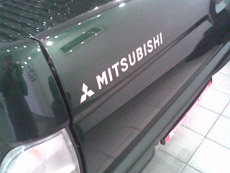 |
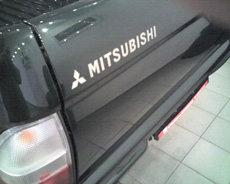 |
(+) increase, 1152x864, JPEG |
(+) increase, 1280x1024, JPEG |
 |
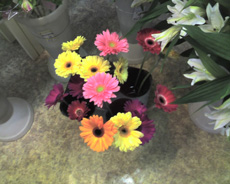 |
(+) increase, 1152x864, JPEG |
(+) increase, 1280x1024, JPEG |
Video recording time can be either unlimited or limited, so it can be attached to an MMS message. Resolution of all clips is 176 õ 144 pixels with three categories of compression. Though these clips don't produce an effect neither on the phone, nor on PC – it's a natural thing for products of this level.
Example of Video 1 (199 Kb)
Example of Video 2 (187 Kb)
All video is recorded in 3GP format, as it was said above, you can set unlimited recording time, though the thing you're limited in is resolution - 176 õ 144 pixels (15 fps) is this camera's peak and can't be even lowered.
Example of video 3 (258 Kb)
Thus what we have to say about the camera: average performance, which makes it usable only on the handset itself since shots if this category are not worthy of viewing on PC and often have lots of artifacts. To tell the truth the manufacturer could integrate a better camera into a device of these dimensions, as we previously saw it by the example of some handsets. Moreover, judging by the range of settings, the device radically differs from Nokia 6280 – there are no various shooting modes, and only one resolution when it comes to shooting clips.
Media player – an application for playing back musical files (in fact it's the same application as Music Player in Nokia 6230i, Media Player is too simplified there). The player supports mp3 files with various bitrates, including the high ones. Playback quality is pretty fair for a phone of this price bracket, there are almost no distortions at all (however bass is not very clear) even when playing back a track using loudspeaker. Moreover, the loudspeaker is something to shout about, as it has great quality of mp3 playback, though polyphonic melodies are pretty average. There is a function for rewinding tracks (both forward and backward). The phone also provides service of translation sound to Bluetooth-headset
 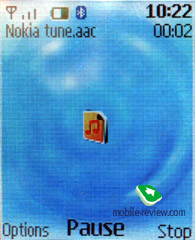
 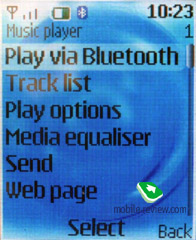
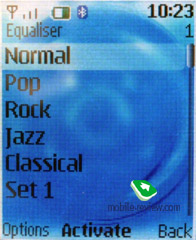 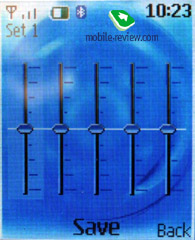
Sound recorder can record up to 60 minutes per one file, can work in call mode.
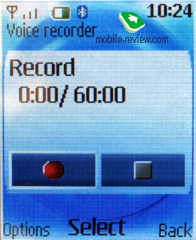
Radio. The device allows to memorize the maximum of 20 FM-stations and assign text names to them. This feature is analogous to other devices by Nokia, changing preset stations can be done by using button on the headset. The radio can work in speakerphone mode, but in this case you'll need to plug in the headset as it will play the role of an antenna. The radio can also be an alarm tone, but still you'll require the headset to be connected to the device. There is no way the radio stream can be recorded.

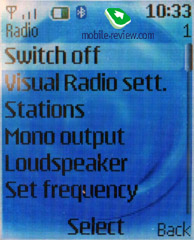 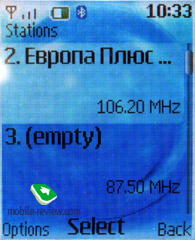
Organiser. You can have from 100 to 250 entries at one time in the organiser, the amount strongly depends on the length of these notes, also there is function for deleting older entries automatically (on the basis of time). The calendar can be viewed in the following modes: month, week with timetable by the hours, quick switch to the entered date is also supported. You can choose out of 5 different types of events (meeting, call, birthday, reminder, note), alarm clock is available for all these events, which can be repeatable as well. While viewing the calendar for month, you will see up to three ongoing events for the chosen day in the bottom of the screen.
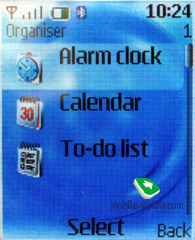 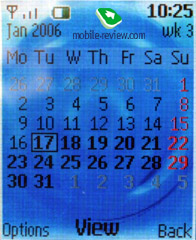
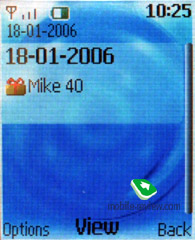 
 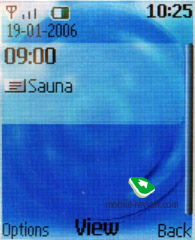
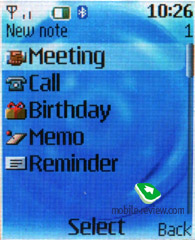 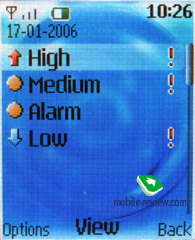
To-do list lets you create events with three levels of priority (high, normal, low) and set a critical date for each of the events
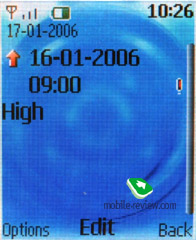 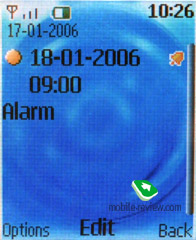
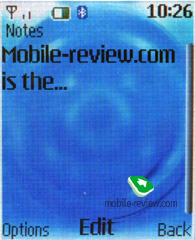
Notes – each note can contain up to 3000 symbols. On the whole it's far more than enough for any user.
Alarm clock allows setting both single alarm and daily repeated with check-boxes for certain days. Any melody or radio stream (headset required) can be an alarm tone. Besides, there is an option to set Snooze time-out.
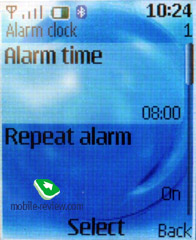 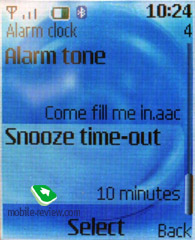
 
In organiser section you can also find countdown and stopwatch, which allow to measure interim results.
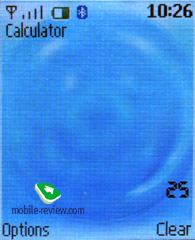 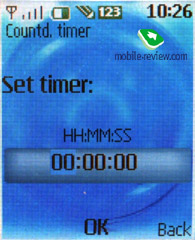
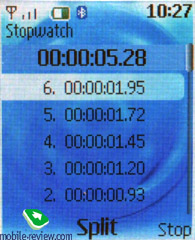
Applications. There are four pre-installed games in the device - Golf Tour, Backgammon (backgammon), Rally 3D (rally), Solitaire (solitaire).
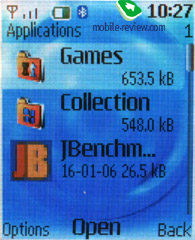 
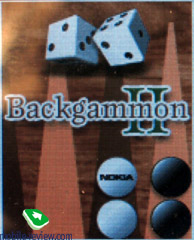 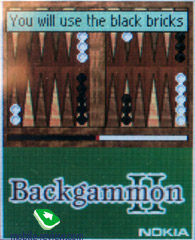
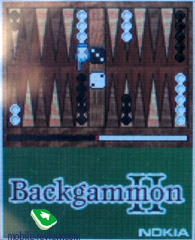 
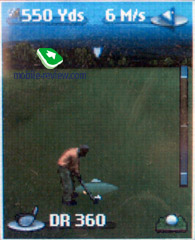 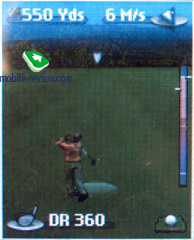
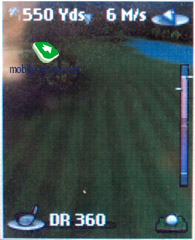 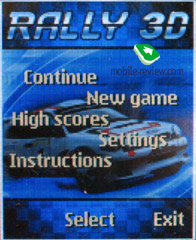
 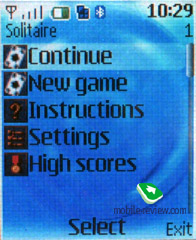

Converter II – allows converting various metric units and at the same time is a currency converter.
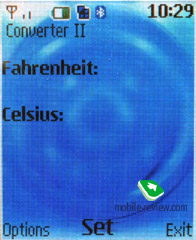
Ìèðîâîå âðåìÿ –
displays current time in different cities of the planet, showing time in several cities simultaneously is also supported.

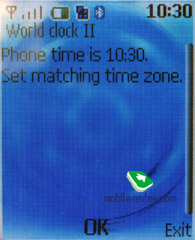 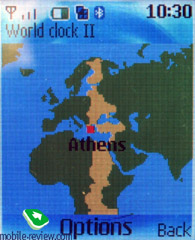
Java applications can be directly installed on the device (Application folder) and afterwards easily run – it wasn't possible in the earlier devices of Nokia, since only wap uploading was supported.
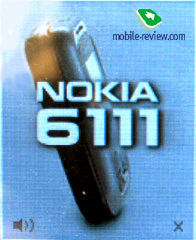
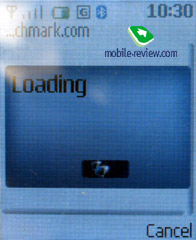 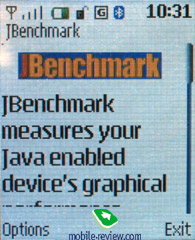
WEB. WAP-browser of version 2 allows to browse xHTML-pages, using TCP/IP. The model provides the support of 3GPP stream video. As to displaying simple pages, this handset doesn't differ from the latest phones developed by the company, though one can consider as a disadvantage low screen resolution (users of Nokia 6230 may not agree with me).
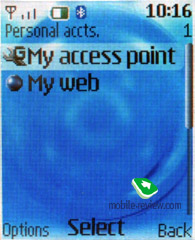 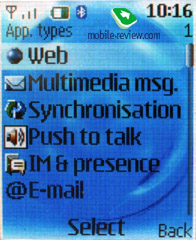
Connectivity . The handset can be successfully used as a modem, since it supports both packet transmission of GPRS class 10, and EDGE (the same class 10). Connection to a PC can be done in any convenient to you way: via Bluetooth, IrDA or using USB-cable. The disadvantage is absence of connection speed indicator (EDGE status is unclear).
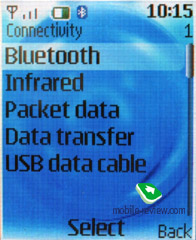
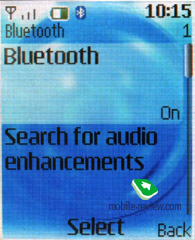 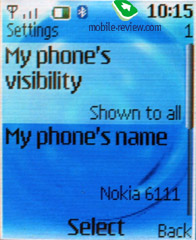
The device supports the following Bluetooth profiles: Hands-free, Headset, Object push profile, File transfer profile, Dial-up networking profile, Voice Gateway, A2DP. B luetooth version is 1.1. When using File Transfer profile, you can view the memory bank of the phone from your PC. Each attempt to access a folder requires confirmation from the side of the phone – it's made for the sake of security. For those, who work on regular basis, it would be better to cancel the queries for the connected devices.
Files of any extensions can be uploaded to the device – they are saved in its memory, so the handset plays the role of storage.
Push to Talk. Nothing special about this, standard functionality

Synchronization with PC. In one box with the phone itself one can find Nokia PC Suite software as well. It's a set of applications, that allows not only to synchronize data taken from the organiser and phonebook with MS Outlook, Lotus, but to upload ring tones, pictures, wallpapers and games as well. This program works in a common manner, after synchronization Russian language is displayed correctly both on PC and handset.
Performance . To measure the performance of the device we used four JBenchmark applications (for MIDP 1.0, 2.0, and also a 3D kit and HD kit). The model displayed good overall results, and proved to be well-optimized for working with 3D models, despite lack of a special accelerator, the performance is on a high level.
|
6111 |
7370 |
6280 |
| JBenchmark 1 |
2336 |
1296 |
1259 |
Details |
| Text |
559 |
303 |
291 |
| 2D Shapes |
547 |
309 |
296 |
| 3D Shapes |
384 |
245 |
248 |
| Fill Rate |
261 |
128 |
127 |
| Animation |
585 |
311 |
296 |
Screen Width
|
128 |
- |
- |
Screen Height
|
115 |
- |
- |
Color Screen
|
true |
- |
- |
Number of Colors
|
16777216 |
- |
- |
Double Buffer
|
true |
- |
- |
Total Memory
|
2097152 |
- |
- |
Free Memory
|
1409068 |
- |
- |
CLDC - 1.1.1 |
Microedition Profile MIDP-2.0 |
Microedition Platform Nokia 6111/03.41 |
ISO-8859-1 |
|
6111 |
7370 |
6280 |
| JBenchmark 2 |
175 |
204 |
214 |
Details |
| Image manipulation |
210 |
162 |
173 |
| Text |
162 |
194 |
206 |
| Sprites |
345 |
311 |
297 |
| 3d Transform |
117 |
223 |
263 |
| User Interface |
117 |
162 |
158 |
Screen Width
|
128 |
- |
- |
Screen Height
|
115 |
- |
- |
Color Screen
|
true |
- |
- |
Number of Colors
|
16777216 |
- |
- |
| JPEG Support |
true |
- |
- |
| Transparency (Alpha Level) |
256 |
- |
- |
Total Memory
|
2097152 |
- |
- |
Free Memory
|
1620576 |
- |
- |
CLDC - 1.1 |
Microedition Profile MIDP-2.0 |
Microedition Platform Nokia 6111/03.41
|
Microedition Encoding ISO-8859-1
|
|
6111 |
7370 |
6280 |
| JBenchmark 3D HQ |
166 |
131 |
141 |
| JBenchmark 3D LQ |
240 |
256 |
274 |
| Triangles ps: |
27674 |
30677 |
29285 |
| kTexes ps: |
867 |
1312 |
1432 |
| Screen(canvas)width: |
128 |
- |
- |
| Screen(canvas)height: |
160 |
- |
- |
3D Subsystem |
| M3G Version: |
1 |
- |
- |
| Antialaising: |
false |
- |
- |
| True color: |
false |
- |
- |
| Dithering: |
false |
- |
- |
| Mipmapping: |
true |
- |
- |
| Perspective correction: |
true |
- |
- |
| Local camera lighting: |
false |
- |
- |
| Max lights: |
8 |
- |
- |
| Max Viewport dimensions: |
1024 |
- |
- |
| Max Texture Dimensions: |
256 |
- |
- |
| Max Sprite Crop Dimensions: |
256 |
- |
- |
| Max Transforms Per Vertex: |
4 |
- |
- |
| Number of Texture Units: |
2 |
- |
- |
Other properties: |
| Color Screen |
true |
- |
- |
| Number of colors |
16777216 |
- |
- |
| Transparency (alpha level) |
256 |
- |
- |
| Double buffer |
true |
- |
- |
| Total memory: |
2097152 |
- |
- |
| Free memory: |
1340588 |
- |
- |
MicroEdition Configuration
|
CLDC-1.1 |
- |
- |
MicroEdition Profiles:
|
MIDP 2.0
|
- |
- |
Microedition Platform:
|
6111/03.41
|
- |
- |
Microedition Encoding:
|
ISO8859-1
|
- |
- |
Microedition Locale
|
en |
- |
- |
Microedition Communication ports:
|
COM0, IR0 |
- |
- |
| Microedition Hostname: |
null |
- |
- |
3.1.0 |
|
6111 |
Rendering Quality: |
Bilinear filtering:
|
Succes (99%)
|
Trilinear Filtering:
|
|
Perspective correction:
|
Failrule (85%)
|
Z-buffer depth:
|
14 bit |
Perfomance: |
Smooth triangles:
|
41128 |
Textured triangles:
|
38872 |
Fill rate:
|
831 |
Gaming:
|
114 (3.8 fps) |
4.0.2 |
Impressions
There is a 64-tones polyphony featured in the device, though with the support of mp3, ÀÀÑ , mp4 files as ring tones, midi files are longer relevant. The ring volume is fairly high, so it can be easily heard, though the power of the vibrating alert is average. Connection quality has no problems at all – you will hear your interlocutor for sure, the same goes to you.
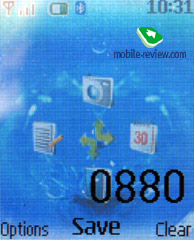 
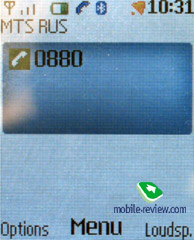 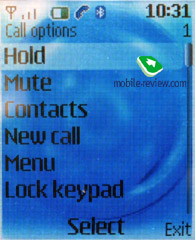
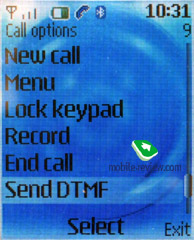 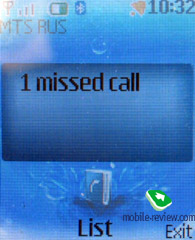
The model has obvious advantages in the form of renovated interface and it's functionality is one of the highest nowadays. Due to small screen resolution all menu items look smooth and occupy the majority of the display. For many this detail will stay unnoted, since it's impossible to spot similar “features” before purchasing a phone.

Assembling quality is common for the latest models of Nokia, the only thing that may cause some issues is the power key, as after a slack falling damage it appears to stick sometimes. The back panel can creak a bit when you're typing a message owing to its minor thickness and peculiarity of attachment. However you can remove this shortcoming by applying fixings of foam-rubber under the panel along the perimeter of the battery.
As a short sum-up I can say that Nokia 6111 doesn't lack small weaknesses, but leaves a favorable impression on the whole. The model will suit both men and women, though it's aimed mostly at the latter.
Taking into consideration, that these are the first steps of Nokia in producing mass sliders, we can rightfully say that to our delight it turned out to be rather good – both functionality and design are on a high level. The device has its own appearance and doesn't look alike handsets of the Korean manufacturers. This fact alone commands respect towards the developers of the company and will attract a certain amount of customers that want to stand out against the background of the masses. No doubt, share of these consumers won't be too big owing to the high price of Nokia 6111, the device costs about 400 USD (this is the price in Russia , on some markets they are already selling this phone at the price of 350 USD). Of course, the price will eventually go down, but the dynamics of the price reduction won't be considerably high, since this model has the only one clear competitor in the form of Siemens SL75. Models of Samsung and other manufacturers are intended either for cheaper share of the market or for more expensive price bracket. But we shouldn't ignore the brand of Nokia that gives at least 20 per cent over the real price of this phone. And so we can witness a unique situation: there are some models in the product line of the company that can compete with Nokia 6111 but they are made in different form-factors. It was primordially predicted that Nokia sliders would become popular, since the company had ignored this form-factor for too long, but some users had already got used to sliders. Actually now the company is aiming at Samsung market share and it's more likely that they will secure the success here.
The company meaningly produces great numbers of sliders with QVGA screens and arms them with memory extension cards slots (e.g. Nokia 6270), so they will not create competition among their own product line. Nokia tries to take consistent steps and doesn't introduce into the market products with high functionality and compact body. It's going to be the next stage, when models of 7xxx will obtain the same capabilities and start competing with the Korean products.
SAR value for this model is - 0.84 Watt/kg.
Eldar Murtazin (eldar@mobile-review.com)
Translated by Oleg Kononosov (oleg.kononosov@mobile-review.com)
Published — 17 February 2006
Have something to add?! Write us... eldar@mobile-review.com
|
News:
[ 31-07 16:21 ]Sir Jony Ive: Apple Isn't In It For The Money
[ 31-07 13:34 ]Video: Nokia Designer Interviews
[ 31-07 13:10 ]RIM To Layoff 3,000 More Employees
[ 30-07 20:59 ]Video: iPhone 5 Housing Shown Off
[ 30-07 19:12 ]Android Fortunes Decline In U.S.
[ 25-07 16:18 ]Why Apple Is Suing Samsung?
[ 25-07 15:53 ]A Few Choice Quotes About Apple ... By Samsung
[ 23-07 20:25 ]Russian iOS Hacker Calls It A Day
[ 23-07 17:40 ]Video: It's Still Not Out, But Galaxy Note 10.1 Gets An Ad
[ 19-07 19:10 ]Another Loss For Nokia: $1 Billion Down In Q2
[ 19-07 17:22 ]British Judge Orders Apple To Run Ads Saying Samsung Did Not Copy Them
[ 19-07 16:57 ]iPhone 5 To Feature Nano-SIM Cards
[ 18-07 14:20 ]What The iPad Could Have Looked Like ...
[ 18-07 13:25 ]App Store Hack Is Still Going Strong Despite Apple's Best Efforts
[ 13-07 12:34 ]Infographic: The (Hypothetical) Sale Of RIM
[ 13-07 11:10 ]Video: iPhone Hacker Makes In-App Purchases Free
[ 12-07 19:50 ]iPhone 5 Images Leak Again
[ 12-07 17:51 ]Android Takes 50%+ Of U.S. And Europe
[ 11-07 16:02 ]Apple Involved In 60% Of Patent Suits
[ 11-07 13:14 ]Video: Kindle Fire Gets A Jelly Bean
Subscribe
|









































































































































































